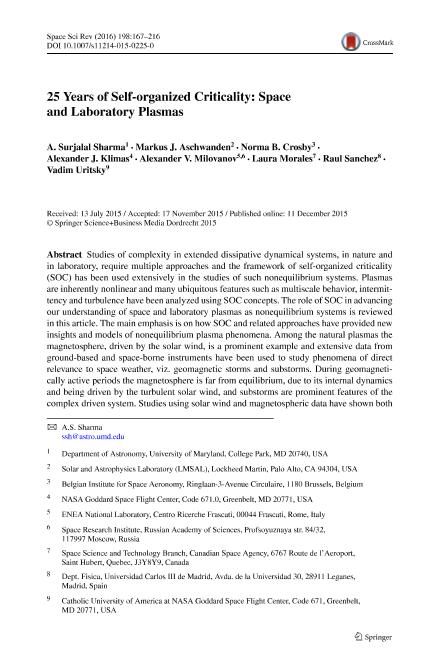Mostrar el registro sencillo del ítem
dc.contributor.author
Sharma, A. Surjalal
dc.contributor.author
Aschwanden, Markus J.
dc.contributor.author
Crosby, Norma B.
dc.contributor.author
Klimas, Alexander J.
dc.contributor.author
Milovanov, Alexander V.
dc.contributor.author
Morales, Laura Fernanda

dc.contributor.author
Sanchez, Raul
dc.contributor.author
Uritsky, Vadim
dc.date.available
2017-06-05T15:38:36Z
dc.date.issued
2016-01
dc.identifier.citation
Sharma, A. Surjalal; Aschwanden, Markus J.; Crosby, Norma B.; Klimas, Alexander J.; Milovanov, Alexander V.; et al.; 25 Years of Self-organized Criticality: Space and Laboratory Plasmas; Springer; Space Science Reviews; 198; 1; 1-2016; 167-216
dc.identifier.issn
0038-6308
dc.identifier.uri
http://hdl.handle.net/11336/17476
dc.description.abstract
Studies of complexity in extended dissipative dynamical systems, in nature and in laboratory, require multiple approaches and the framework of self-organized criticality (SOC) has been used extensively in the studies of such nonequilibrium systems. Plasmas are inherently nonlinear and many ubiquitous features such as multiscale behavior, intermittency and turbulence have been analyzed using SOC concepts. The role of SOC in advancing our understanding of space and laboratory plasmas as nonequilibrium systems is reviewed in this article. The main emphasis is on how SOC and related approaches have provided new insights and models of nonequilibrium plasma phenomena. Among the natural plasmas the magnetosphere, driven by the solar wind, is a prominent example and extensive data from ground-based and space-borne instruments have been used to study phenomena of direct relevance to space weather, viz. geomagnetic storms and substorms. During geomagnetically active periods the magnetosphere is far from equilibrium, due to its internal dynamics and being driven by the turbulent solar wind, and substorms are prominent features of the complex driven system. Studies using solar wind and magnetospheric data have shown both global and multiscale features of substorms. While the global behavior exhibits system-wide changes, the multiscale behavior shows scaling features. Along with the studies based on observational data, analogue models of the magnetosphere have advanced the understanding of space plasmas as well as the role of SOC in natural systems. In laboratory systems, SOC has been used in modeling the plasma behavior in fusion experiments, mainly in tokamaks and stellarators. Tokamaks are the dominant plasma confinement system and modeling based on SOC have provided a complementary approach to the understanding of plasma behavior under fusion conditions. These studies have provided insights into key features of toroidally confined plasmas, e.g., the existence of critical temperature gradients above which the transport rates increase drastically. The SOC models address the transport properties from a more general approach, compared to those based on turbulence arising from specific plasma instabilities, and provide a better framework for modeling features such as superdiffusion. The studies of space and laboratory plasmas as nonequilibrium systems have been motivated by features such as scaling and critical behavior, and have provided new insights by highlighting the properties that are common with other systems.
dc.format
application/pdf
dc.language.iso
eng
dc.publisher
Springer

dc.rights
info:eu-repo/semantics/openAccess
dc.rights.uri
https://creativecommons.org/licenses/by-nc-sa/2.5/ar/
dc.subject
Multiscale Phenomena
dc.subject
Nonequilibrium Systems
dc.subject
Self-Organized Criticality
dc.subject
Space Plasmas
dc.subject
Tokamaks
dc.subject
Turbulence
dc.subject.classification
Física de los Fluidos y Plasma

dc.subject.classification
Ciencias Físicas

dc.subject.classification
CIENCIAS NATURALES Y EXACTAS

dc.title
25 Years of Self-organized Criticality: Space and Laboratory Plasmas
dc.type
info:eu-repo/semantics/article
dc.type
info:ar-repo/semantics/artículo
dc.type
info:eu-repo/semantics/publishedVersion
dc.date.updated
2017-06-05T14:47:42Z
dc.journal.volume
198
dc.journal.number
1
dc.journal.pagination
167-216
dc.journal.pais
Alemania

dc.journal.ciudad
Berlín
dc.description.fil
Fil: Sharma, A. Surjalal. University Of Maryland; Estados Unidos
dc.description.fil
Fil: Aschwanden, Markus J.. Lockheed Martin Corporation; Estados Unidos
dc.description.fil
Fil: Crosby, Norma B.. Belgian Institute For Space Aeronomy; Bélgica
dc.description.fil
Fil: Klimas, Alexander J.. Nasa Goddard Space Flight Center; Estados Unidos
dc.description.fil
Fil: Milovanov, Alexander V.. Russian Academy Of Sciences. Space Research Institute; Rusia. Enea Centro Ricerche Frascati; Italia
dc.description.fil
Fil: Morales, Laura Fernanda. Canadian Space Agency; Canadá. Consejo Nacional de Investigaciones Científicas y Técnicas; Argentina
dc.description.fil
Fil: Sanchez, Raul. Universidad Carlos Iii de Madrid. Instituto de Salud; España
dc.description.fil
Fil: Uritsky, Vadim. Nasa Goddard Space Flight Center; Estados Unidos
dc.journal.title
Space Science Reviews

dc.relation.alternativeid
info:eu-repo/semantics/altIdentifier/doi/http://dx.doi.org/10.1007/s11214-015-0225-0
dc.relation.alternativeid
info:eu-repo/semantics/altIdentifier/url/https://link.springer.com/article/10.1007%2Fs11214-015-0225-0
Archivos asociados
